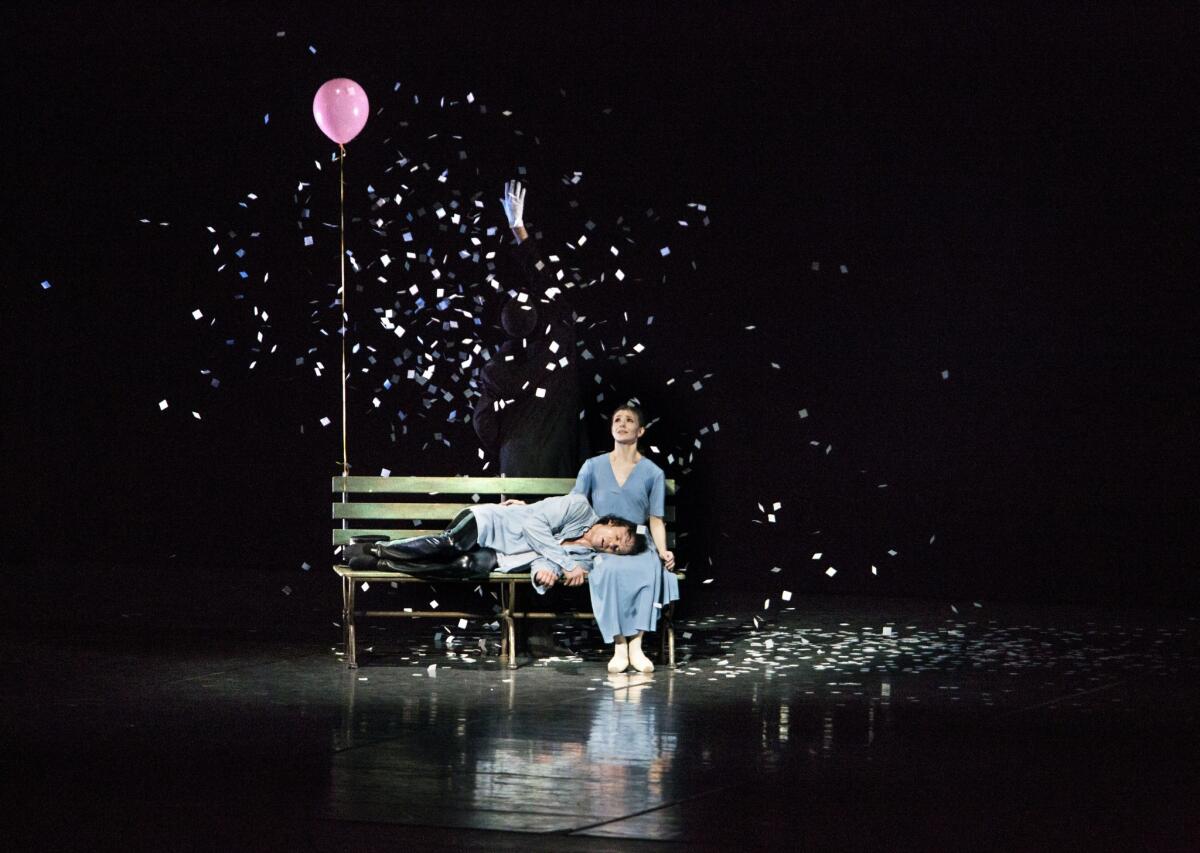Dance review: Hamburg Ballett’s U.S. premiere of powerful ‘Liliom’

- Share via
In the contemporary ballet “Liliom” -- based on a 1909 play of the same name, which Rodgers & Hammerstein turned into the musical “Carousel” -- Hamburg Ballett choreographer-director John Neumeier sends the audience home with a surprising hopefulness surrounding the iconic, central couple.
The German company gave “Liliom” its American debut this weekend at the Segerstrom Center for the Arts.
The carnival barker Liliom bestows his final kiss on the innocent Julie, and this confirmation of shared love had particular power and promise Friday night. Thanks to tour-de-force interpretations by the exhilarating Carsten Jung as Liliom, and the emotionally truthful Alina Cojocaru as Julie, this act became an ending of affirmation and cathartic beauty.
PHOTOS: Best dance moments of 2013
Before this magical conclusion, though, “Liliom” (2011) was something of a jumble of highs and lows: visually rich with its seedy, exotic Playland (Ferdinand Wögerbauer, set design); choreographically protracted; yet colorfully acted by Hamburg’s top-drawer international cast.
Neumeier calls his two-act work a “ballet legend”; a danced play is another descriptor. A spectacular score by prolific French composer Michel Legrand (“The Thomas Crown Affair”) was like a rushing current, cuing the scenes. Legrand, who was there to take a bow at the curtain call, created both an orchestral work (heard in recording) and big-band jazz pieces, played by local musicians who were seated on an upstage platform and who performed with swinging enthusiasm. Jules Buckley conducted flawlessly, without any missed entrances.
These two musical styles alternated almost seamlessly, though sometimes predictably -- jazz for the sex scenes, for example. The composer wrote a haunting, central minor chord to thematicaly represent Julie and Liliom, and at least one woman was heard humming it out the door.
Neumeier’s choreography flowed atop the music, not so much interpreting it rhythmically as reflecting its tone and colors. Dancers’ gestures amplified their characters’ personalities and made visual their interior monologues, their DNA.
PHOTOS: Arts and culture in pictures by The Times
The muscular Jung, with his shirt off, was full of swagger, angular arms and thigh-slapping bravado as the carnival barker. Cojocaru blossomed from withdrawn girl to stoic mother, her rounded, hoop-like arms an embrace not just for her lover but also for the whole world.
One of the finest ballerinas today, Cojocaru was almost underutilized here. But her central pas de deux with Jung was an ode to honesty and self-revelation, a highlight moment for their characters and the viewers.
As we have come to expect from Hamburg, the entire ensemble was terrific, whether dancers were portraying the Depression-era unemployed fighting one another for jobs, shrieking girls at the carnival or the red-suited “devils” in the after-life.
Aleix Martínez was vigorous and authentic as Louis, Julie and Liliom’s mournful and angry son. This gender switch (the character was written as a girl) added a layer of depth to his relationship with Liliom.
Dario Franconi brought intimidating evil to the disjointed steps of Ficsúr. Leslie Heylmann was Julie’s bubbly friend Marie. And Sasha Riva was the mime Balloon Man, part-narrator, part-symbol, perhaps, of lost childhood.
What will become of Louis was not so clear. But Neumeier seems to have hope for Julie.
----------------------------------------------------------
Hamburg Ballett, “Liliom,” Segerstrom Hall, 600 Town Center Drive, Costa Mesa, 7:30 p.m. Saturday [today], 2 p.m. Sunday [tomorrow]. www.scfta.org
More to Read
The biggest entertainment stories
Get our big stories about Hollywood, film, television, music, arts, culture and more right in your inbox as soon as they publish.
You may occasionally receive promotional content from the Los Angeles Times.










